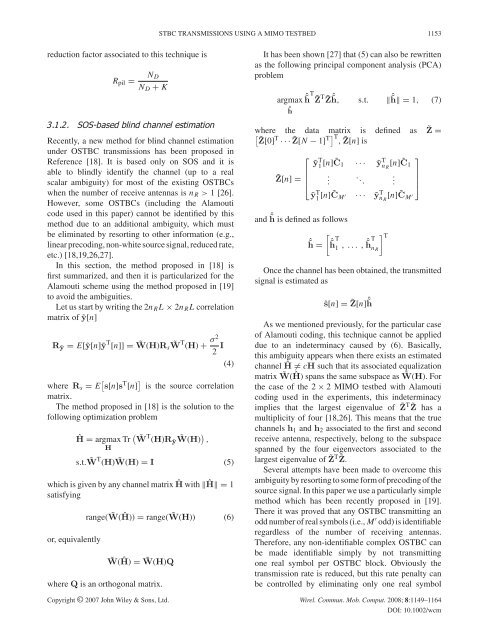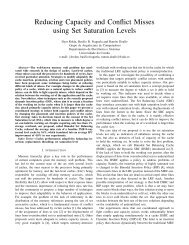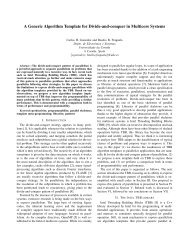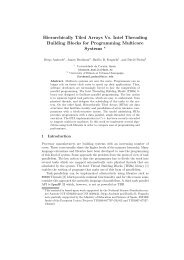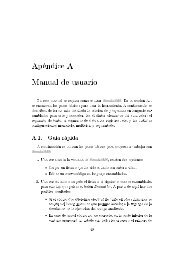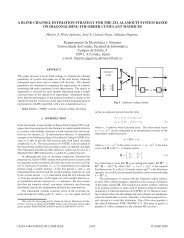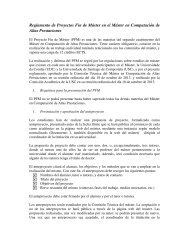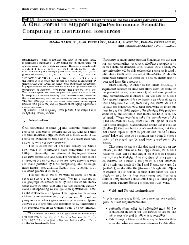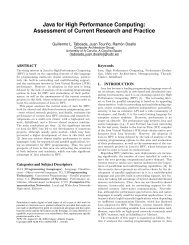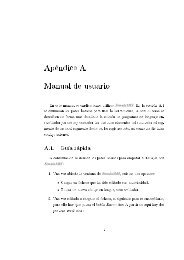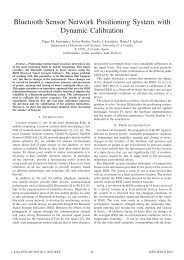2 MIMO testbed - GTEC
2 MIMO testbed - GTEC
2 MIMO testbed - GTEC
- No tags were found...
Create successful ePaper yourself
Turn your PDF publications into a flip-book with our unique Google optimized e-Paper software.
STBC TRANSMISSIONS USING A <strong>MIMO</strong> TESTBED 1153reduction factor associated to this technique isR pil =N DN D + K3.1.2. SOS-based blind channel estimationRecently, a new method for blind channel estimationunder OSTBC transmissions has been proposed inReference [18]. It is based only on SOS and it isable to blindly identify the channel (up to a realscalar ambiguity) for most of the existing OSTBCswhen the number of receive antennas is n R > 1 [26].However, some OSTBCs (including the Alamouticode used in this paper) cannot be identified by thismethod due to an additional ambiguity, which mustbe eliminated by resorting to other information (e.g.,linear precoding, non-white source signal, reduced rate,etc.) [18,19,26,27].In this section, the method proposed in [18] isfirst summarized, and then it is particularized for theAlamouti scheme using the method proposed in [19]to avoid the ambiguities.Let us start by writing the 2n R L × 2n R L correlationmatrix of ỹ[n]Rỹ = E[ỹ[n]ỹ T [n]] = ˜W(H)R s ˜W T (H) + σ22 I (4)where R s = E [ s[n]s T [n] ] is the source correlationmatrix.The method proposed in [18] is the solution to thefollowing optimization problemĤ = argmax Tr ( ˜W T (H)Rỹ ˜W(H) ) ,Hs.t. ˜W T (H) ˜W(H) = I (5)which is given by any channel matrix Ĥ with ‖Ĥ‖ =1satisfyingor, equivalentlyrange( ˜W(Ĥ)) = range( ˜W(H)) (6)˜W(Ĥ) = ˜W(H)Qwhere Q is an orthogonal matrix.It has been shown [27] that (5) can also be rewrittenas the following principal component analysis (PCA)problemargmaxˆ˜hˆ˜h T ˜Z T ˜Z ˆ˜h, s.t. ‖ ˆ˜h‖ =1, (7)where the data matrix is defined as ˜Z =[ ˜Z[0] T ··· ˜Z[N − 1] T] T , ˜Z[n] is⎡ỹ1 T[n] ˜C 1 ··· ỹ T ⎤n R[n] ˜C 1˜Z[n] = ⎢⎣.. ... .. ⎥⎦and ˆ˜h is defined as followsỹ T 1 [n] ˜C M ′ ··· ỹ T n R[n] ˜C M ′[ˆ˜h = ˆ˜h T 1 , ... , ˆ˜h] T Tn ROnce the channel has been obtained, the transmittedsignal is estimated asŝ[n] = ˜Z[n] ˆ˜hAs we mentioned previously, for the particular caseof Alamouti coding, this technique cannot be applieddue to an indeterminacy caused by (6). Basically,this ambiguity appears when there exists an estimatedchannel Ĥ ≠ cH such that its associated equalizationmatrix ˜W(Ĥ) spans the same subspace as ˜W(H). Forthe case of the 2 × 2 <strong>MIMO</strong> <strong>testbed</strong> with Alamouticoding used in the experiments, this indeterminacyimplies that the largest eigenvalue of ˜Z T ˜Z has amultiplicity of four [18,26]. This means that the truechannels h 1 and h 2 associated to the first and secondreceive antenna, respectively, belong to the subspacespanned by the four eigenvectors associated to thelargest eigenvalue of ˜Z T ˜Z.Several attempts have been made to overcome thisambiguity by resorting to some form of precoding of thesource signal. In this paper we use a particularly simplemethod which has been recently proposed in [19].There it was proved that any OSTBC transmitting anodd number of real symbols (i.e., M ′ odd) is identifiableregardless of the number of receiving antennas.Therefore, any non-identifiable complex OSTBC canbe made identifiable simply by not transmittingone real symbol per OSTBC block. Obviously thetransmission rate is reduced, but this rate penalty canbe controlled by eliminating only one real symbolCopyright © 2007 John Wiley & Sons, Ltd. Wirel. Commun. Mob. Comput. 2008; 8:1149–1164DOI: 10.1002/wcm


